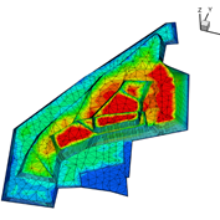Besides agriculture, landfills constitute the second largest source of anthropogenic methane (CH4) in Europe. Methane accounts for about 20% of the global warming gases, the impact on the greenhouse effect is 25 times higher than that of carbon dioxide; therefore it is a matter of public interest to reduce methane emissions from landfills to a minimum.
A passive methane oxidation layer is a suitable and an economical alternative to treat lean gas emissions. Within such a layer methanotrophic bacteria oxidate methane under aerobic conditions into less harmful carbon dioxide and water with CH4 + 2O2 -> CO2 + 2H2O +883kJ.
Based on a coupled biphasic model predicting gas production in landfills, a prediction simulation is being developed to describe the functionality and performance of the methane oxidation layer. To describe this complex problem, the well-known Theory of Porous Media (TPM) combined with the Mixture Theory is used in order to develop a multiphase finite element calculation concept. The model analyzes the relevant gas productions of methane, carbon dioxide and oxygen, and accounts for the driving phenomena of production, diffusion and convection. It considers as well the environmental conditions like surrounding temperature or pH-value, which can influence the methane degradation.
Project partners
- Prof. Dr.-Ing. J. Bluhm
Institute of Mechanics Department Civil Engineering, University of Duisburg-Essen - Prof. Dr.-Ing. R. Widmann, Prof. Dr. M. Denecke, M. Sc. T. Gehrke
Institute of Waste Management Department Municipal Water- and Waste Management, University of Duisburg-Essen - Prof. Dr. T. C. Schmidt, M. Sc. M. Schulte
Institute of Analytical Chemistry, Faculty of Chemistry, University of Duisburg-Essen

Andrea Thom
Dr.-Ing.Researcher





